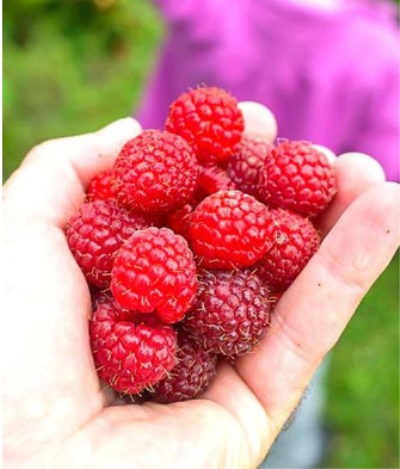
- Berry color: dark purple
- Taste: sweet
- Ripening period: average
- Berry weight, g: up to 9
- Yield: from 7 to 12 kg per bush
- Frost resistance: high
- Appointment: universal
- Keeping quality: Yes
- Watering: plentiful
- Yield rate: very high
Raspberries are a true natural healer. The fragrant sweet berries appear in the middle of summer and are eaten fresh. They are added to compotes and delicious jam is prepared. One of these varieties is Canadian raspberry.
Description of the variety
Raspberry Canadian belongs to the standard varieties. In terms of technical characteristics, it surpasses many varieties. Bushes with powerful sturdy stems grow up to 200 cm and have a compact shape due to erect branches. Plant without thorns with good branching. Dark green leaves with a corrugated surface.
Ripening terms
Raspberry Canadian is considered a medium early variety. The first fruiting begins in June - July. Repeatedly - in September, where young shoots give a harvest.
Growing regions
A poorly studied variety is grown in all nurseries in Russia. It is gaining popularity for its hardiness to any climatic conditions.
Yield
Raspberry Canadian is a high-yielding variety. Fruiting of one bush can reach from 7 to 12 kg of berries. This figure is several times higher than the values of many classic raspberry varieties.
Berries and their taste
Large berries of a dark purple color of universal significance and a conical shape weigh up to 9 grams. Canadian raspberry pulp is dense, but at the same time juicy and sweet with a raspberry aroma. The berries are stored for a long time and are suitable for transportation.

Growing features
Raspberry bushes will actively develop in a sunny area, protected from drafts. Regular grooming is important, especially watering.
Site selection and soil preparation
Saplings are planted in places that exclude the close passage of groundwater. Suitable soil is drained, alkaline, loamy with an acidity level of 5, 5-6, 2 pH. For planting, prepare holes 50x50 cm.The distance between the bushes is left from 1.5 to 2 meters.
Spring is the best time to plant trees. It is necessary to have time to plant a seedling before the buds begin to bloom. In autumn plantings, the bush is spud to protect the roots from the cold.


Pruning
At the beginning of spring, pinching of the tops is carried out, thereby forming the correct rounded shape of the bush. The tree should have 5-7 tops. This procedure increases the yield and the formation of peduncles.In spring and autumn, it is necessary to remove dry, damaged branches and prevent thickening of the raspberry tree.

Watering and feeding
In the spring, the Canadian raspberry variety is fed with nitrogen fertilizers to form greenery.
For these purposes, infusions of mullein are used, diluted 1 to 10, bird droppings - 1 to 20, from herbs - 1 to 10. Urea is also suitable.
In July, they are fed with potash fertilizers. You can buy a ready-made complex mineral fertilizer, superphosphate. Effectively using 1 glass of ash per sq. m. Can be applied periodically throughout the season.
In the fall, nitrogen-containing fertilizers must be excluded.
Raspberry Canadian moisture-loving, and the size of the fruit depends on it. Regular watering is essential during flowering and ripening of the berries. Before the onset of cold weather, the soil is moistened to avoid freezing of the roots.
In summer, the Canadian raspberry withstands a short-term drought. In the heat, watering is carried out twice a week. A drip irrigation system is practiced. You can dig grooves and let water through them. Regular loosening improves oxygen access to the roots. After watering, it is good to mulch the soil with foliage, straw to retain moisture in the ground.


Frost resistance and preparation for winter
The Canadian raspberry variety is not afraid of frost. But the protection of the root system must be taken care of in advance. First, they remove the mulch around the plant, there may be pests. After the soil freezes, a new layer of mulch is laid around the bush. The bushes of this raspberry are difficult to bend the first time due to the thickness of the stem. Therefore, this is done in several stages, covered with agrofibre.

Diseases and pests
Raspberry Canadian - highly resistant crop to various diseases and pests. But regular preventive measures will not hurt:
in early spring, the soil is cultivated in the aisles to get rid of pests that have wintered in the ground;
during the formation of buds, they are sprayed with Aktion, Aktellik;
during flowering, diseased bushes and branches are removed;
after the completion of the collection of berries, the fruiting branches are removed, and treated with drugs or Bordeaux liquid.

Unfortunately, raspberries, like other plants, do not bypass various diseases and pests. Only armed with the knowledge and the necessary means for this, you can cope with such troubles. To help the plant, it is very important to be able to recognize the disease in time and begin timely treatment.
Reproduction
Reproduction by cuttings and young shoots is possible.
Cuttings. Dig out the bush, and choose the root part with 1-2 formed buds. The seedling is placed in prepared soil of equal parts of sand and peat. For better rooting, a warm place is suitable.
Young shoots are separated from the mother bush, taking care not to damage the root system. They are planted separately in prepared soil.

Review overview
According to reviews, Canadian standard raspberries are able to provide the whole family with a harvest. Unpretentious care allows you to grow it everywhere. More and more gardeners are learning about this wonderful variety and are happy to grow it on their plots.







































































